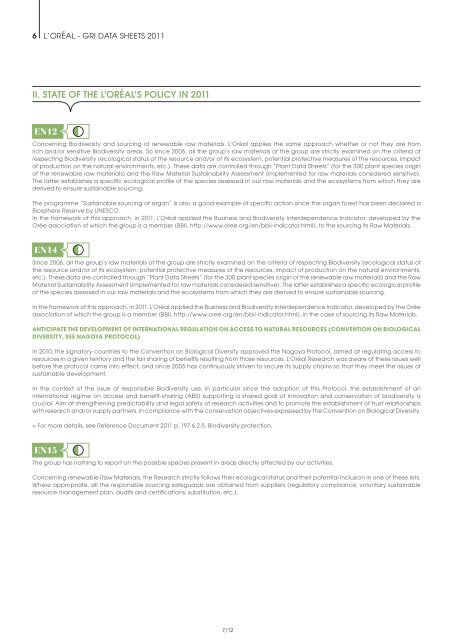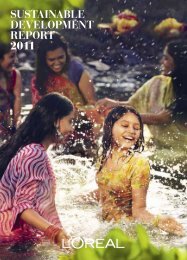Organizational Strategy - Sustainable Development - L'Oréal
Organizational Strategy - Sustainable Development - L'Oréal
Organizational Strategy - Sustainable Development - L'Oréal
You also want an ePaper? Increase the reach of your titles
YUMPU automatically turns print PDFs into web optimized ePapers that Google loves.
6 L’oréaL - GrI DaTa SHEETS 2011<br />
II. STATE OF THE L’ORéAL’S POLICY IN 2011<br />
EN12<br />
Concerning Biodiversity and sourcing of renewable raw materials, L’oréal applies the same approach whether or not they are from<br />
rich and/or sensitive Biodiversity areas. So since 2006, all the group’s raw materials of the group are strictly examined on the criteria of<br />
respecting Biodiversity (ecological status of the resource and/or of its ecosystem, potential protective measures of the resources, impact<br />
of production on the natural environments, etc.). These data are controlled through “Plant Data Sheets” (for the 300 plant species origin<br />
of the renewable raw materials) and the raw Material Sustainability assessment (implemented for raw materials considered sensitive).<br />
The latter establishes a specific ecological profile of the species assessed in our raw materials and the ecosystems from which they are<br />
derived to ensure sustainable sourcing.<br />
The programme “<strong>Sustainable</strong> sourcing of argan” is also a good example of specific action since the argan forest has been declared a<br />
Biosphere reserve by UNESCo.<br />
In the framework of this approach, in 2011, L’oréal applied the Business and Biodiversity Interdependence Indicator, developed by the<br />
orée association of which the group is a member (BBII, http://www.oree.org/en/bbii-indicator.html), to the sourcing its raw Materials.<br />
EN14<br />
Since 2006, all the group’s raw materials of the group are strictly examined on the criteria of respecting Biodiversity (ecological status of<br />
the resource and/or of its ecosystem, potential protective measures of the resources, impact of production on the natural environments,<br />
etc.). These data are controlled through “Plant Data Sheets” (for the 300 plant species origin of the renewable raw materials) and the raw<br />
Material Sustainability assessment (implemented for raw materials considered sensitive). The latter establishes a specific ecological profile<br />
of the species assessed in our raw materials and the ecosystems from which they are derived to ensure sustainable sourcing.<br />
In the framework of this approach, in 2011, L’oréal applied the Business and Biodiversity Interdependence Indicator, developed by the orée<br />
association of which the group is a member (BBII, http://www.oree.org/en/bbii-indicator.html), in the case of sourcing its raw Materials.<br />
ANTICIPATE THE DEVELOPMENT OF INTERNATIONAL REGULATION ON ACCESS TO NATURAL RESOURCES (CONVENTION ON BIOLOGICAL<br />
DIVERSITY, SEE NAGOYA PROTOCOL)<br />
In 2010, the signatory countries to the Convention on Biological Diversity approved the Nagoya Protocol, aimed at regulating access to<br />
resources in a given territory and the fair sharing of benefits resulting from those resources. L’oréal research was aware of these issues well<br />
before the protocol came into effect, and since 2005 has continuously striven to secure its supply chains so that they meet the issues of<br />
sustainable development.<br />
In the context of the issue of responsible Biodiversity use, in particular since the adoption of this Protocol, the establishment of an<br />
international regime on access and benefit-sharing (aBS) supporting a shared goal of innovation and conservation of biodiversity is<br />
crucial. aim at strengthening predictability and legal safety of research activities and to promote the establishment of trust relationships<br />
with research and/or supply partners, in compliance with the conservation objectives expressed by the Convention on Biological Diversity.<br />
> For more details, see reference Document 2011 p. 197 6.2.5. Biodiversity protection.<br />
EN15<br />
The group has nothing to report on the possible species present in areas directly affected by our activities.<br />
Concerning renewable raw Materials, the research strictly follows their ecological status and their potential inclusion in one of these lists.<br />
Where appropriate, all the responsible sourcing safeguards are obtained from suppliers (regulatory compliance, voluntary sustainable<br />
resource management plan, audits and certifications, substitution, etc.).<br />
7/12






